Ruta de navegación
Blogs
Local Tribes Call for Benefit-Sharing and Reduction of Environmental Damage
The social stability of Nigeria, one of the most populous countries in the world and the largest in the world, is the world's largest Economics of Africa, is of international concern because of its potential impact on continental and global security. Hence, a local conflict such as the one between the tribes of the Niger Delta and the Nigerian government, as a result of the exploitation of the abundant oil of the area, be followed closely from the outside.

▲The area of light at the bottom of the satellite image corresponds to the oil facilities of the Niger Delta [NASA]
article / Baltasar Martos
The fierce dispute over energy resources at the mouth of the Niger River in southern Nigeria has been one of Africa's most high-profile conflicts for decades. The marginalization, confinement, and impoverishment of the Ogoni and Ijaw – the name given to the ethnic tribes in the coastal provinces of Rivers, Bayelsa, and Delta – have contributed to an escalation of tension between locals and the federal government.
In order to understand the underlying problem, it is first necessary to take a brief look back in time and discern the three chronological stages that have shaped the current panorama of the conflict, namely: the beginning of oil exploitation, the hegemony of Royal Dutch Shell and the post-independence period.
In 1903, in the southern coastal region of present-day Nigeria, which became a British protectorate (1901) and later a colony (1914), a large deposit of minerals and hydrocarbons, such as coal, bitumen, oil and natural gas, was discovered. The British company Nigeria Properties Ltd. then began oil exploration and extraction, reaching a production of 2,000 barrels per day in 1905. Later, in 1937, and after the succession of several oil companies, the Anglo-Dutch multinational Royal Dutch Shell acquired a monopoly on the exploration of oil sources – and, to a lesser extent, other hydrocarbons – reaching a number of fees production of 5,000 barrels per day.
Three decades later, following independence and the official establishment of the Federal Republic of Nigeria (1960-1963), the military government of Yakubu Gowon embarked on a policy of nationalization and acquisition of foreign firms in the country, forcing them by legal mandate to re-register through joint ventures with state-owned enterprises. In this way, he managed to transform this activity into the main strategic sector for the Economics of the country. In addition, taking into account the entrance Nigeria joined OPEC in 1971, it is not surprising that the federal government currently owns 60% of the capital stake in practically all the oil companies in operation, occupying an important role as a leader in the country. partner majority.
On the contrary, the civilian population in the area has result The big loser. The ethnic minorities most affected by prospecting, extraction and commercialization activities – with the consequent enrichment for some and environmental pollution for others – have been demanding the attention of the government and demanding legislative measures for environmental and social protection for decades [1].
On the one hand, locals demand "environmental justice," defined by the U.S. Environmental Protection Agency as "fair treatment and meaningful participation in political decision-making processes about activities that affect the natural environment of all peoples, regardless of race, color, culture... concerning the implementation and enforcement of environmental laws, regulations, and policies."
The Ogoni and Ijaw are peoples dedicated mainly to agriculture and fishing as a means of subsistence, for whom the natural environment is the only and main one source of wealth. They are protesting against the long-standing collusion (since independence) between the government and multinational oil companies, calling them both "expropriators and polluters" and blaming them for the impoverishment of the region and the deplorable state of the rivers that flow through it. They also claim their rights to obtain and use, for their local communities, the corresponding share of the profits derived from the exploitation of energy deposits because they are traditionally located on a large pocket of crude oil [2].
Corruption, clientelism and the structural weakness of the government, added to its great interest in and dependence on this sector – which has come to be a benefit for the Economics The national increase of up to 55% of GDP in the mid-1990s according to World Data Bank statistics – makes it extremely difficult for the president and his cabinet to agree to address the needs of these communities in the Niger River Delta. The growing protests led to a real conflict, which began in the last decade of the last century, pitting the civilian population against the federal government in collusion with the multinationals. This confrontation has taken two forms, one peaceful and the other violent, and has attracted the media attention of a large part of the international community.
International Attention
On the other hand, the conflict in the Niger Delta is a clear case of globalization, since oil extraction involves a set of transnational forces, non-state actors and interdependent processes. Fruit of the prolonged status In response to the discontent of the indigenous tribes of the area, two movements have grown in denunciation of profit by a government that barely invests in the development of this region of the country, mired in poverty and poverty. withdrawal, and degraded by the exploitation of its natural resources.
On the one hand, there is the Movement for the Survival of the Ogoni People (MOSOP), created in the wake of protests in the 1990s and used as a model for other civil associations to publicly express their dissatisfaction with the negative impacts of the oil industry on the quality of life of the inhabitants of the area. This organization, started by writer Ken Saro-Wiwa and composed mainly of academics and teachers, peacefully denounces the joint actions of the government and the corporations installed in the area and advocates for the civil human rights of the Ogoni to decent housing conditions, environmental justice and legislation that respects and protects them from environmental threats.
On the other hand, there is the Movement for the Emancipation of the Niger Delta (MEND). It is made up of an amalgam of armed youth groups organized into local resistance militias, whose goal The main one is to fight for control of the oil benefits for the ethnic minorities settled in the area. This is a military branch of MOSOP that has already sabotaged oil pipelines and kidnapped foreign factory workers, demanding ransom from the government on several occasions.
The most important thing about both movements is that they have caught the attention of a large number of people. issue local and international non-governmental organizations that have partnered with them and have begun to promote and to make their cause visible to the entire international community. Amnesty International, Human Rights Watch and the Niger Delta Human and Environmental Rescue Organization are some of the many organisations that have opened a space for work devoted solely and exclusively to the question of the Niger Delta. They advocate worldwide for the defense of the environmental rights of communities affected by the exploitation of resources and the pollution of the natural environment. They have also been able to partner with transnational media and human rights networks to spread the status from conflict to a global audience.
The joint denunciation of the "alleged violations of human and environmental rights against the members of the Ogoni ethnic group of the Niger Delta" has resonated worldwide and has obtained a significant sum of economic aid aimed at the re-establishment of the settlements from which the indigenous peoples had been displaced, as well as the promotion of environmental justice. the protection and guarantee of the civil rights of locals to take advantage of the natural wealth of their area, the continuation of their economic activities and the safeguarding of their environment. The global impact of this conflict is likely to have an impact on how similar conflicts are resolved.
[1] Obi, Cyril. "Insights from the Niger Delta", Young, Tom. Readings in the International Relations of Africa. Indiana University Press, 2016.
[2] Botchway, Francis N., ed. Natural Resource Investment and Africa's Development. Edward Elgar Publishing, 2011.
DOCUMENT FROM work / María Granados Machimbarrena
SUMMARY
Despite the HIRSI and JAMAA judgment of 2012, Italy was condemned in 2015 once again by the European Court of Human Rights for unlawful detention and summary and collective refoulement of several migrants. The events occurred in 2011, when the applicants travelled in a boat across the Mediterranean and were intercepted by Italian vessels. The migrants were transferred to the island of Lampedusa, and detained at the Centro di Soccorso e Prima Accoglienza (CSPA), in a area reserved for Tunisian nationals. According to the complainants, they were detained in overcrowded and filthy rooms, without contact with the outside. The events took place immediately after the Arab Spring. The issues raised before the Court by the applicants and the arguments raised by the judges are relevant in the current context of the European crisis in the management handling of refugee flows by the EU institutions and its Member States.
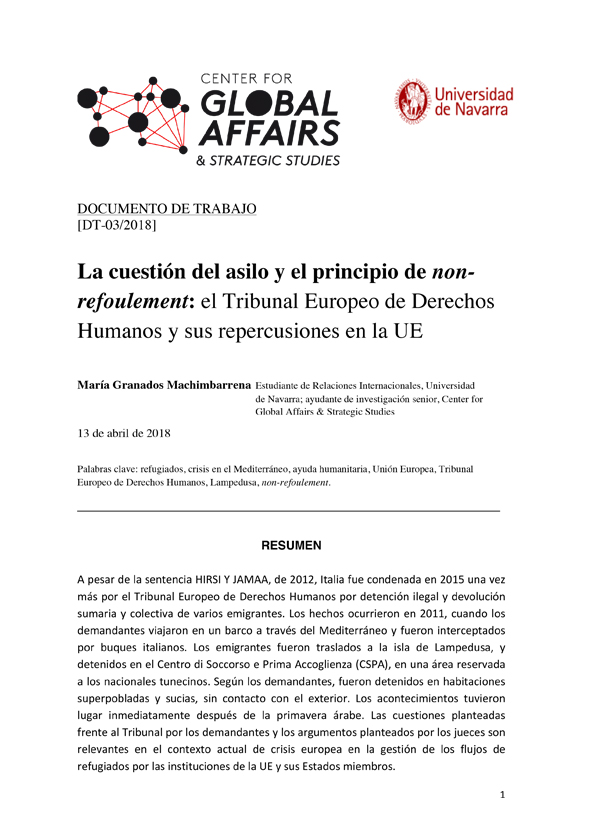 download the complete document [pdf. 6,4MB] [pdf. 6,4MB
download the complete document [pdf. 6,4MB] [pdf. 6,4MB
China, India and Japan are investing in their respective air forces with an eye on the neighbor
North Korea is making headlines about space-faring weaponry, but it is Asia's great powers – China, India and Japan – that are striving for full air potential.

▲Chinese J-20 Stealth Fighter
article / Sebastian Bruzzone
North Korea is not the most powerful military air power in Asia. The exuberant parades and frequent ballistic missile launches by this nation are certainly far from their actual firepower, although they invest roughly 15% of their GDP in it. Military air hegemony is mainly in three centres-states:
Japan. The Japanese air force, established in 1954, combines its level of technique and sophistication with U.S. aircraft. Both countries, also with South Korea, carry out exercises in the airspace of the Pacific Ocean. Its aviation fleet varies from generation to generation. It has modern F-15 and F-2 aircraft manufactured by Mitsubishi Industries (Japanese, national company) and Lockheed Martin (American company), and older aircraft such as the Phantom F-4. Similarly, it has an early warning team and attendance and another for tanker planes to keep the rest of the aircraft in the air for as long as possible.
India. The Indian Air Force possesses Soviet and domestic technology, as well as a training system and management of the British Royal Air Force. Its fleet has 300 state-of-the-art fighters supplemented by older MiG-21s. In addition, 200 offensive ground attack aircraft and C-17 Globemasters in the field of logistics to ensure cargo transport and refueling and immediate warning.
China. Since the end of World War II, the Chinese government has invested in its aerial weaponry to become the continent's leading military power. Today, it has 600 fighters of the 4th and 4.5th generations, as well as the aircraft of the aforementioned countries. Unlike Japan and India, the main manufacturer of their equipment is the country itself and they have not been imported from any other nation. What stands out most about the Chinese Air Force is the evolution in recent years. It has gone from having a very large and poorly trained fleet to being made up of pilots who can spend more than 24 hours on a plane. However, the Chinese aviation industry still has quality issues in its engines. Still, we may be talking about the most important air power in Asia.
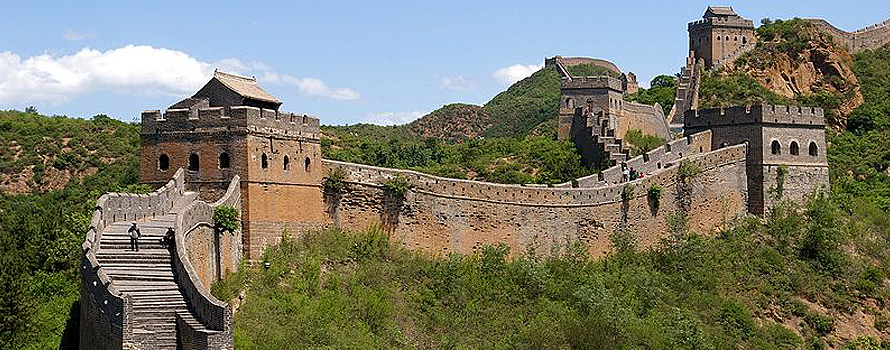
▲Great Wall of China, near Jinshanling [Jakub Halin-Wikimedia Commons]
COMMENTARY / Paulina Briz Aceves
The Great Wall of China was completed after decades of successive efforts by different dynasties, not only as a defensive line, but also as a sign of China's attitude towards the outside world. Although this wall currently has no use, other than to be a tourist attraction, it has been an example for the creation of another great wall, which, although not physical, has the same effects as the original: isolating the Chinese community from the outside world and protecting itself from attacks that threaten its sovereignty.
The "Great Firewall of China" – the government's online surveillance and censorship effort – monitors all traffic in Chinese cyberspace and allows authorities to both deny access to a variety of selected websites, and disconnect all Chinese networks from the Internet. network of the Internet. In addition to the Great Firewall, the Chinese government has also created a domestic surveillance system called the "Golden Shield," which is administered by the Ministry of Public Security and others Departments government and local agencies. The Chinese government understands how valuable and powerful technology, innovation, and the Internet are, which is why it is cautious about information disseminated on Chinese soil, due to its constant fear of possible questioning of the Communist Party and disruption of China's political order.
China's cyber policies and strategies are barely known in the international world, but what is known is that China's network security priorities are motivated by the goal the main challenge of the Communist Party to stay in power. China's rulers understand that cybernetics are something that is already fully integrated into society. Therefore, they believe that in order to maintain political stability, they must keep an eye on their citizens and control them, leaving them in the shadows by censoring not only general information, but also sensitive issues such as the massacre in the city. place Tiananmen or Hong Kong's Umbrella Revolution .
Filters that control what citizens see on the web have become more sophisticated. In addition, the government has employee around 100,000 people to monitor the Chinese internet, to control information not only coming from the West, but even that which is generated in China itself. It is true that this meddling in the media has undoubtedly caused the Chinese government to assert its power over society, because it is clear that whoever has the information definitely has the power.
[Pedro Baños, Así se domina el mundo. Desvelando las claves del poder mundial. Ariel, Barcelona 2017, 468 pages]
review / Albert Vidal
The vast majority of wars fought in the world always have a vital economic background, although other motives (political or religious, for example) are often used to safeguard these economic interests. The book Así se domina el mundo, by the analyst and researcher Pedro Baños, former head of Counterintelligence and Security of the European Army Corps, with experience in various international missions (UNPROFOR, SFOR and EUFOR), states that economic interests are the ones that rule the International Office is the main thesis , illustrated with great issue of examples, an d is supported by the book Así se domina el mundo, by the analyst and Pedro Baños, former head of Counterintelligence and Security of the European Army Corps, with experience in various international missions (UNPROFOR, SFOR and EUFOR).
"The United States is still trying to dominate the world. But its big competitor is China. Especially when it comes to the economic sphere. That is why they wage economic war, and also through interposed actors in many scenarios. Everything has an economic substratum," writes Colonel Baños. China, for its part, is determined to strike a blow against the dollar. Beijing is preparing a new contract format for crude oil transactions using the yuan, which would be fully convertible into gold on the Shanghai and Hong Kong exchanges. If this were to happen, it would lead to the main reference letter of the Asian oil market, and allow crude exporters to circumvent the dollar-dominated benchmarks.
Afghanistan is another example of the primacy of Economics in geopolitics. The US decided to return to Afghanistan, where, coincidentally, opium production has multiplied. This had been reduced by the Taliban to minimal levels, as they banned opium cultivation and the Afghans switched to cotton production. But then, according to Baños, a strong civil service examination arose from the US cotton producers, so that some US states rebelled because they felt that the skill of cheap Afghan cotton could ruin them. Baños points out that there are Pentagon reports recommending such intervention. Moreover, Afghanistan is extremely rich in minerals. That is why Donald Trump declared that "China is making money in Afghanistan with rare minerals while the United States makes war".
These appreciations confirm the realistic and pragmatic way in which Baños interprets the events taking place in the world. His vision of geopolitics is integrated into political realism, close to Machiavelli's interpretation. He has a Hobbesian vision of the international scenario. He defines current geopolitics as "the activity developed with the aim of influencing the affairs of the international sphere, this exercise being understood as the aspiration to influence on a global scale, while avoiding, at the same time, being influenced".
This book is a great opportunity to enrich our perspectives on the international scene. With simple language, Baños manages to convey complex concepts through different images. One of them, central to the book's thesis , is the comparison of the international scenario with a playground at high school: in the playground (the world), the great powers (the bullies) enjoy circumstantial allies (cowardly children who decide to join the court of sycophants); then there are outcasts (who suffer the malice of the bullies) and others who simply resist the pressure of group or decide to isolate themselves from the group of students. Hypocrisy, as the author well describes, is a constant in the International Office.
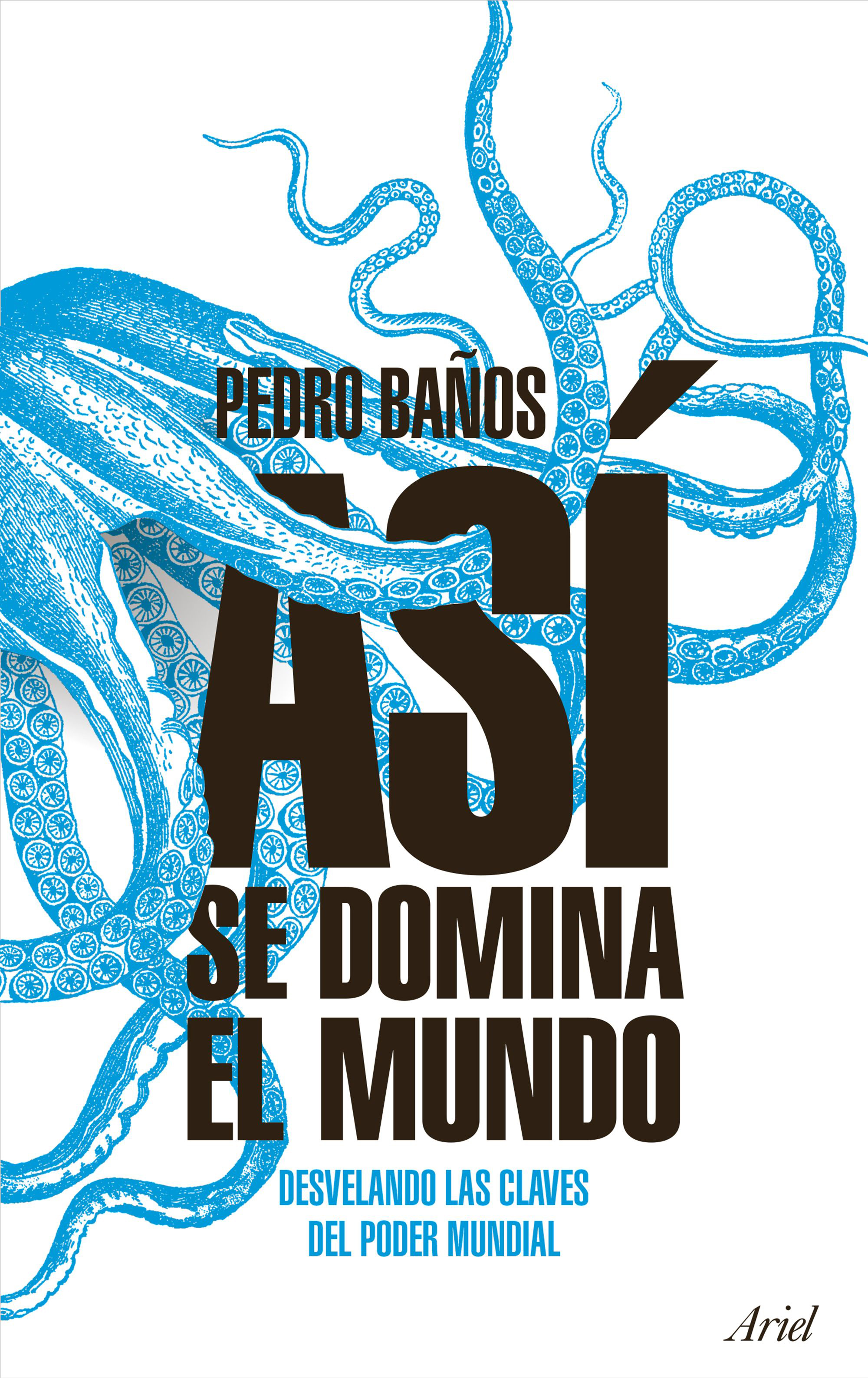 |
Geopolitical principles, geostrategies and errors
Baños presents four immutable geopolitical principles that, in essence, have always been present in history (even if there are accidental changes). They could be summarized as follows:
-
The State is a living being, which has vital and existential needs, as well as those of development and evolution.
-
The Economics is in charge, the backbone of conflicts and the source of tensions. These are economic interests often related to the arms industry.
-
The determining weight of history, with repetition of the same scenarios, such as Afghanistan (its orography has been a graveyard for empires and superpowers) and Russia (with a winter that ruined the plans of Napoleon and Hitler).
-
There are no eternal allies, but permanent interests. Interests create strange alliances, and these alliances are often ephemeral. For example, Saudi Arabia is one of the main allies of the USA, when their values, in principle, are totally contradictory.
After the description of geopolitical principles, the book reviews 27 geostrategies that have been recurrently used on the international scene. This section is very useful for understanding many of the movements or events occurring in the world. Some examples of such geo-strategies are:
-Theintimidation of a strong country towards other weak countries, using them for their own interests.
-Theencirclement and counterencirclement.
-Thekick to the ladder. Examples are the refusal of the atomic powers to allow others to join the nuclear club and the obligation that developed countries impose on underdeveloped economies to open up to the free market.
-Theweakening of the neighbor.
-The breaking point.
-Fostering divisionby sowing tares.
-Religious fervor as tool to gain followers.
-Goodism. In the Syrian war, we have seen killings by the Islamic State, but the killings by the international coalition, which in our eyes appear to be the rescuers of the Syrian people, have been systematically hidden.
¬Thecreation of the need. The need to buy weapons is based on concepts such as war on terrorism, preventive strategy, and others, which result in a fabulous business of buying and selling weapons.
-Indirect domination. Between 1946 and 2000 the White House has interfered in 81 elections in 45 countries, according to declassified CIA documents.
-Thecreation of the enemy. NATO and the USA encourage the enmity of Western countries towards Moscow, so that they become subordinate to NATO and ask it for protection and buy weapons from it,
-Themadman. This is a strategy used by North Korea, threatening catastrophic consequences to avoid being attacked.
Banos also exposes the mistakes that powers often make in their international actions. A couple of them are:
-
Ignoring the idiosyncrasies of peoples. The Western world is composed, at most, of 900 million people. The rest of the world is home to 6.6 billion. On the other hand, globalization is basically Anglo-Saxon: not all peoples necessarily want to participate in it. And given the biased view we have of the world, we often have a wrong conception of other peoples. The sad reality is that many interventions abroad are carried out without any subject study or examination of the potential consequences on the cultures and peoples affected.
-
Excessive self-confidence. There is no small enemy, not even an asymmetric one. With guerrilla tactics, even a group of peasants can become a real threat to the plans of a great power. In fact, history has repeatedly shown how those who have acted too confidently have been defeated by their more cautious adversaries.
Post-truth and disinformation
Pedro Baños stresses the importance of narratives. According to the author, to have one's own narrative is to win the game. The narrative makes reality mutate. And narratives become an instrument of emotional control of the population, which serves to justify what suits them.
On the other hand, it makes reference letter to the truth, which runs the risk of being reconstructed to justify national or corporate interests. The citizenry, says Colonel Baños, must be vigilant: "those who decide for us do so subtly, even resorting to the so-called 'post-truth', which is nothing but a big lie disguised as truth". As the author points out, the core topic of power is to influence a deliberately uninformed world, in which many conflicts of interest between states, individuals, companies, lobbies and powerful families are intermingled, all trying to exert as much influence as possible.
The cyber world is the new great stage for this battle. A very intense psychological and propaganda war is being waged there, led by fake news and disinformation. These two worlds (one physical and the other virtual) are connected by the human mind. That is why it is vital to be wary of attacks that, although we may not realize it, take place every day, veiled or not. The powers are in continuous action, with only one purpose, as Baños concludes: "to control the world and avoid being subjugated by another power. That is the only goal".
It generates many of the raw materials necessary for the global technology production
China not only has significant reserves of mineral resources, but also leads the world production of many of them. This gives it a remarkable geopolitical leverage as a source of the essential resources for global technology production.
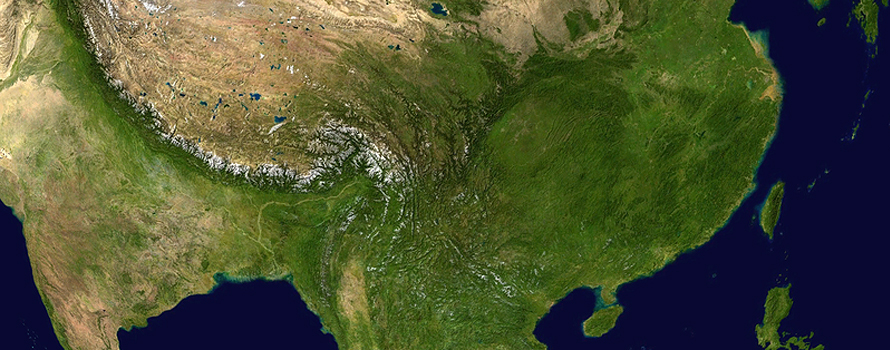
▲Satellite imagery [NASA].
ARTICLE / Gabriel Ros Casis [English version] [Spanish version].
With a vast amount of territory as the Asian country has, it is obvious to think that it is a land with plenty of raw material and natural resources. Through China's history, this has become a strong geopolitical asset, not only for the country's development itself but for its trading partners through exports. Nowadays, when talking about these raw materials, China stands out in two main groups: base metals and technology elements.
The group of base materials essentially comprises five metals from the periodic table, these being iron, copper, aluminum, magnesium and zinc (and sometimes, lead and tin are also included). No need to say that most we can find all these metals in everyday-life objects, and that they have been the backbone of the industry for many time. Therefore, every country needs them, placing countries with bigger deposits of these metals on a strategic advantage. But the mineral wealth of a country doesn't always relate to the later since it can also be measured by the ease and viability of the extraction of the product. In the case of China, both statements would be suitable since the country has the world's biggest deposits of many of these minerals, leading with magnesium, (79% of global extractions), tin (43%) and zinc (31%).
Regarding the technology metals, it is important to note that they include several minerals such as rare earth elements, precious metals as well as semiconductors. Quantitatively speaking, the amount of these metals needed is minimal, even though their availability is crucial to produce today's technology. For instance, some of the most common technology metals include some such as lithium, yttrium, palladium, cerium and neodymium, which can be found in smartphone batteries, medicines, magnets or catalysts. Once again China leads with the biggest deposits of some of these elements, highlighting tungsten deposits (83%), rare earths (78%) and molybdenum (38%).
As it can be drawn from this, not only has China the largest deposits on these materials but also it is the world's number one exporter. Apart from the extraction, the country also refines and manufactures components with minerals such as the aluminum, copper and certain rare earths and in some cases even manufacturing the final product.
Hence, it must be taken into account that the extraction carries several consequences. Environmentally, the extraction always has an impact on the land, maybe minor in China if compared with other countries (because of its massive extension), but still significant. Economically, these extractions entail a big cost, but if managed properly, they can generate a huge revenue. In the political scenario, they are seen as an important geopolitical advantage by making other countries dependent on the supplies.
As a conclusion, it can be drawn from this that China has a great power when it comes to raw material resources, but this comes with a great liability since a substantial part of the commodities used for almost all global technology production depends on this country, which provides the resources but also manufactures them.
It generates many of the raw materials needed for global technology production.
China not only has significant reserves of mineral resources, but also leads the world in the production of many of them. B This gives it a geopolitical advantage as source of the resources essential for global technological production.

▲Satellite image [NASA].
article / Gabriel Ros Casis [English version].
With such a vast territory as the Asian country, it is obvious to think that it possesses a large amount of raw materials and natural resources. Throughout China's history, this has become a strong geopolitical asset, not only for the country's own development but also for its trading partners through exports. Today, when we talk about these raw materials, China stands out in two main groups: base metals and technological elements.
The group of the base metals essentially comprises five metals from the periodic table, these being: iron, copper, aluminum, magnesium and zinc (sometimes lead and tin are also included). There is no need to recall that we can find all these metals in everyday objects, and that they have been the backbone of industry for a long time. Therefore, every country needs them, placing those with the largest deposits of these metals at a strategic advantage. But a country's mineral wealth is not always given by this condition, as it can also be measured by the ease and feasibility of extracting the product. In the case of China, both arguments would be valid, since the country has the largest deposits of many of these minerals, with magnesium leading the way (79% of global extractions) followed by tin (43%) and zinc (31%).
As far as technological metals are concerned, it is important to note that they include various minerals, such as rare earths, precious metals, as well as semiconductors. From a quantitative approach , the required amount of these metals is minimal, even though their availability is crucial for the production of today's technology. For example, some of the most common technology metals include lithium, yttrium, palladium, cerium and neodymium, which can easily be found in cell phone batteries, medicines, magnets or catalysts. Once again, China leads the way with the largest deposits of several of these elements, especially tungsten (83%), followed by rare earths (78%) and molybdenum (38%).
From this we can conclude that China not only has the largest deposits, but is also the world's leading exporter. In addition to extraction, this country also refines and manufactures components with minerals such as aluminum, copper and certain rare earths, and in some cases even manufactures the final product.
Therefore, it must be taken into account that extraction brings with it certain consequences. Environmentally, extraction always has an impact on the land, perhaps less in China compared to other countries (due to the size of its territory), but equally significant. From an economic approach , these extractions entail a great cost, but which, managed in the right way, can generate an immense benefit. In the political scenario, they are seen as an important geopolitical advantage, creating dependence on the demand of other countries.
As a conclusion, it can be drawn from this that China has great power in terms of raw material resources, but this carries with it a great responsibility, since a substantial part of the raw materials used for almost all the world's technology production depends on this country, which provides the resources, but also manufactures them.
DOCUMENT OF work / Lucía Serrano Royo
SUMMARY
The European Union was born as a mechanism for cooperation between countries, but its recent history means that the system is still very fragile. At the same time, its diversity makes decision-making complex and numerous political interests come into play, which can conflict. One of the most relevant events that is currently taking place and that has shaken the pillars of the Union is "Brexit", the exit of the United Kingdom as a member state of the Union. This paper will analyze the slow implementation of the article 50 of the Treaty on European Union, which is activated for the first time in history. In addition, it analyzes the reasons in the European and internal context that have led to this status and the consequences from a political, economic and social point of view. Faced with this climate of instability and uncertainty, different alternatives to this will be proposed. status and it will analyse how the European Union has responded to this problem in its White Paper, where different scenarios for the continuation of the Union have been established.
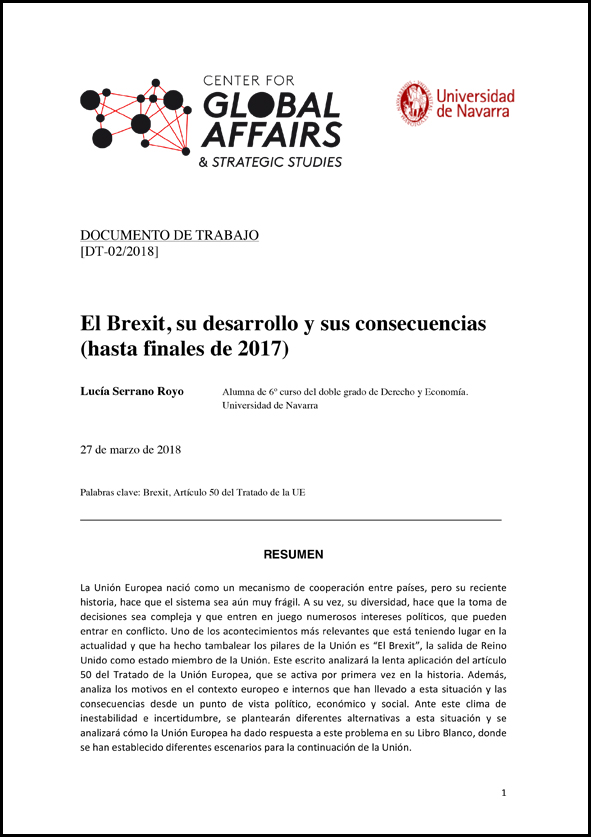 download the complete document [pdf. 4.4MB]
download the complete document [pdf. 4.4MB]

▲Street art in the city of Medellín
ANALYSIS / María Gabriela Fajardo
Colombia experienced on March 11 the first elections held after signature in 2016 of the Peace agreement between the government and the guerrillas of the Revolutionary Armed Forces of Colombia (FARC). These elections to the country's bicameral congress - members of the Senate and the House of Representatives were elected - were the first occasion in which the different ideological sectors could measure their forces without the distortion of an armed struggle in significant parts of the territory. Traditionally, social rejection of the guerrilla campaign has been alluded to as an explanation for why the left in Colombia has usually enjoyed little popular support. Has the arrival of peace changed the correlation of political forces and has it led to an improvement in the electoral results of the left?
To answer these questions, we will examine the results obtained by the different political options, grouped into sections of the ideological spectrum (right, center-right, center-left and left), in the elections to congress held since the beginning of this century. An examination of the political composition of congress over the last decade and average will give perspective to the results of the March 11 legislative elections. These elections meant the integration of the FARC into the Colombian political party system, under a different name - Fuerza Alternativa Revolucionaria del Común - but with the same acronym.
In the 2002-2018 period there were also, in addition to the five elections to the congress, as many presidential elections. The latter are mentioned in the analysis because they help to clarify the contexts, but they are not included in the comparative work , given that the presidential elections are governed by more personalistic dynamics and complex vote transfers take place due to the double round process. The March 11 elections, however, provide considerations for the presidential elections of May 27.
Senate
The Parapolitics scandal distorted the reception of the results of the 2002 legislative elections, after paramilitary chief Salvatore Mancuso claimed that 35% of the elected congress were "friends" of his organization. The right wing, represented by the Liberal Party and the Conservative Party, won 41.1% of the Senate seats. This figure does not include the seats won by other minor political groups, among them Colombia Siempre, whose head of list was the current candidate presidential candidate Germán Vargas Lleras. The left, on the other hand, was quite fractioned, in groups such as Vía Alterna and Movimiento Popular Unido, and obtained 14% of the Senate seats. The center-left won 12.9% and the center-right 7%.
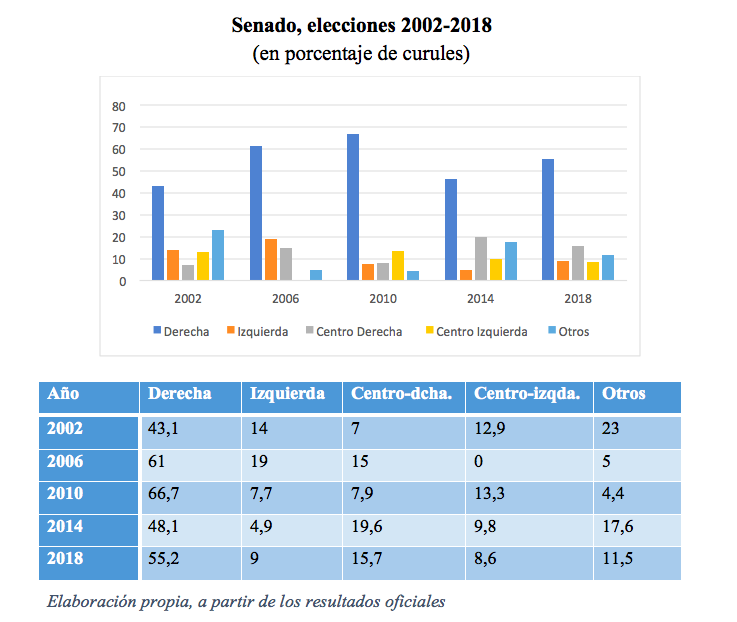 |
In the 2002 presidential elections, held a few months after the legislative elections, Álvaro Uribe became head of state, with the vote of 53.1% of the voters. Uribe ran as an independent candidate , after splitting from the Liberal Party, and had the support of much of the right and center-right, including Cambio Radical, Somos Colombia and the Conservative Party, which then did not participate in the presidential race.
Thus, in the 2006 legislative elections, a new party, the Partido Social de Unidad Nacional (better known as Partido de la U), created by Álvaro Uribe, played a major role. The Partido de la U won the elections, obtaining 20% of the seats: for the first time neither of the two traditional parties (Liberal and Conservative) had won result . The new party was here to stay, so that the right wing was now represented by three parties (de la U, Liberal and Conservative), with 61% of the senators. The left, although it increased to 19% of the Senate seats, was split into several political parties without weight and without the possibility of proposing drastic legislative changes. The center-right, represented by Cambio Radical, was in fourth place, with 15% of seats, while the center-left obtained none.
In 2010 the right wing reached its highest point, with 66.7% of the Senate seats, a figure that includes the three right-wing parties mentioned above and MIRA, a group with a smaller presence. These were moments of political dominance for Uribismo. In the electoral months of 2010, President Uribe was expressing his support to Juan Manuel Santos as candidate presidential. It was thought that he would continue Uribe's policies of confronting the guerrillas and organizing the security forces. However, after coming to power, Santos surprised by disassociating himself from Uribe and opening negotiations with the FARC in 2012, which led to the rupture of the relationship between the two politicians (El periodico, 2017). The strength demonstrated by the right in the 2010 legislative elections was accompanied by a great weakness of the left, which obtained only 7.7% of the Senate seats and would become the perfect ally of President Santos to carry out his diary and his journey towards the political center. The center-left had a representation of 13.3%, thanks to the push of the new Alianza Verde party, and the center-right remained at 7.9%.
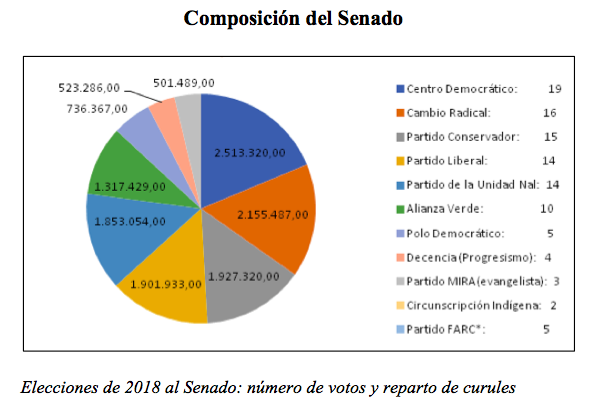 |
The 2014 legislative elections meant the consolidation of a new right-wing party, the Democratic Center, created by Uribe after his separation from the U Party, which had been left in the hands of Santos, who that year would win reelection as Colombian president. The Democratic Center came in second place in the Senate elections, with only one senator less than the U Party (Sanchez, 2018). In 2014, the right went on to control 48.1% of the Senate, from agreement with the ideological realignment of the party system. Thus, several experts came to classify the Partido de la U as center-right, label which they also began to grant to the Partido Liberal, in a political space shared with Cambio Radical; these three parties formed the "Unidad Nacional" (Castillo, 2018). With this, the center-right totaled 19.6% of the seats, while the center-left obtained 9.8%, due to the votes achieved by the Green Party and the Progressives, the latter led by Gustavo Petro, current presidential candidate . The left only reached 4.9%, represented by the minorities of the Polo Democrático, the Unión Patriótica, Marcha Patriótica and the groups that came from the demobilized guerrillas.
In the legislative elections of March 11, there was a reinforcement of right-wing positions, with the return of some parties which in previous elections had slid towards the center-right by defending the negotiation with the FARC and which now wanted to counteract the fear of part of the population of a rise of the radical left, in a very polarized electoral process. Thus, the right rose to 55.2% of the senators, led by those of the Democratic Center, while the center-right fell to 15.9%. The moderate and radical left increased their presence: the center-left rose to 11.5% and the left to 9%. This last percentage does not include the five seats guaranteed to the FARC, which despite not winning any senator electorally, will have those five seats guaranteed by the Peace Accords.
House of Representatives
The results in the 2002-2018 period of the elections for the House of Representatives, held simultaneously with those for the Senate, do not differ much from what was discussed in the previous epigraph; however, they present some variations that should be considered.
The institution was quite affected by parapolitics scandals, a factor that influenced the political polarization of the country, which would be reflected in the elections throughout this period. In 2002, the right won 47% of the seats in the House, with the Liberal Party having the largest representation; the left won 27.1%. From then on, the center-right, which in 2002 obtained 4.2% of the representatives (the center-left took 1.8%) began to take a certain configuration, as the contours of the two traditional parties -Conservative and Liberal- blurred with the division into factions, from which new parties would emerge; this ended the bipartisanship experienced in Colombia throughout the 20th century: the Conservative governed for 48 years and the Liberal for 13.
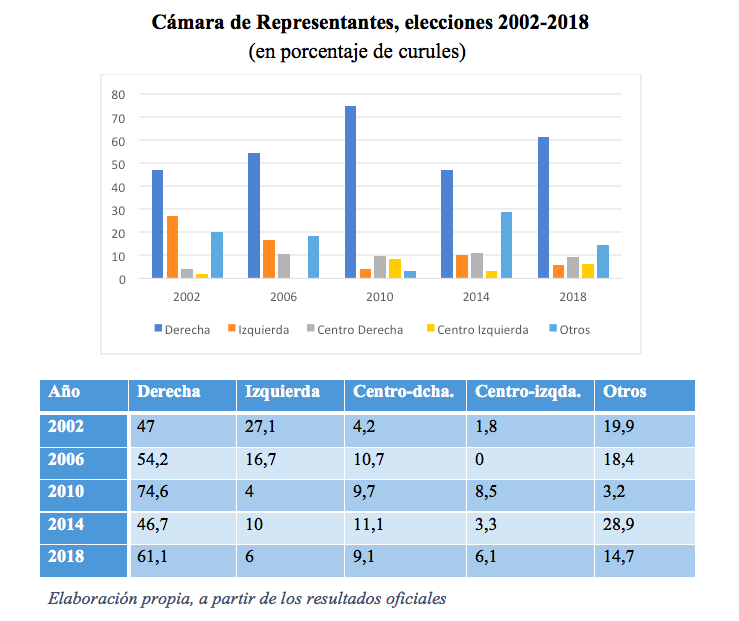 |
The emergence of the Partido de la U, led by Álvaro Uribe and the wide acceptance of his political figure (Uribe became president in 2002 and was reelected in 2006), led for the first time a party other than the two traditional ones to come in second place in the 2006 legislative elections, in which the Partido de la U won 16.7% of the seats in the Chamber, raising the representation of the right to 54.2%. For its part, the left dropped its representation to 16.7% and entered a period of special political weakness (these elections were not good for the center-left either, which did not obtain representation). At a time of President Uribe's successes against the guerrillas, with measures supported by a large part of the population, although not without controversy, the left-wing parties were weighed down by sharing certain ideological assumptions with the guerrillas, as political scientist Andrés Dávila of the Universidad de los Andrés Dávila of the Universidad de los Andres points out.
This dynamic led to an even greater increase of the right wing and a new decline of the left wing in the House of Representatives in 2010, in parallel with what happened in the Senate, in a year in which the candidate promoted by Uribe, Juan Manuel Santos, would also win the presidency. The Partido de la U was ahead of the Liberal Party and the Conservative Party in the House of Representatives, with these three right-wing parties accounting for 74.6% of the seats, the highest percentage of the entire period studied; the center-right party reached 9.7%. For its part, the left, whose largest party was the Polo Democrático, reached only 4%, its worst share in the period, minimally compensated by the maximum representation of the center-right, although this was a modest 8.5%.
The 2014 elections brought with them the presence of a new party headed by Uribe, the Democratic Center, which positioned itself to the right of the previous ones by positioning itself forcefully against the continuation of the peace dialogues with the FARC propitiated by President Santos (El periodico, 2017). The rupture between Santos and Uribe caused their electorate to split, so that in the elections to the House of Representatives the Liberal Party won, followed by the U Party, the Conservative Party and the Democratic Center. Taking into account the shift towards more moderate positions of some of these formations, when grouping them together we have that the right-wing advocates dropped to 46.7% of the seats in the House, while the center-right rose to 11.1%. The left, with the Polo Democrático, improved its representation somewhat to 10%, and the center-left languished at 3.3%.
Four years later, last March 11, the Liberal Party won again the elections to the House of Representatives, followed by the Democratic Center, the Radical Change, the U Party and the Conservative Party. Some of these formations returned during the electoral campaign to clear right-wing positions that they had previously moderated, so that the right wing added 61.1% of the seats (Sánchez, 2018), compared to 6% for the left. For its part, the center-right scored 9.1% and the center-left 6.1%. To these figures must be added the five seats in the House granted by the agreement de Paz to the FARC, which also failed to win any by citizen vote, as in the Senate. With this enlargement, the Colombian bicameral congress goes from 268 to 280 members (the ten members of the FARC party and two that will correspond to the presidential ticket that comes second in the presidential elections).
 |
The division of the left
The analysis carried out allows us to affirm that right-wing political approaches have remained in the majority in Colombia so far this century, as was the case in previous decades, although no longer in the hegemonic framework of two major parties, but of a wider range of partisan options. In a period in which in many other Latin American countries there were turns to the left -notably, the Bolivarian revolutions- Colombia was a clear exception. In this time, the right in Colombia (not including the center-right) has controlled between 43.3% (2002) and 66.7% (2010) of the Senate seats and between 46.7% (2014) and 74.6% (2010) of those in the House of Representatives. In contrast, the left (not including the equally reduced center-left) has remained a minority: it has moved between 4.9% (2014) and 19% (2006) of the Senate, and between 4% (2010) and 27.1% (2002) of the House.
The 2016 Peace agreement and the integration of the FARC into political life have so far not led to a significant electoral boom of the left. In the legislative elections of March 11, 2018, the right actually recovered positions compared to 2014 in the two institutions of the Contreso, while the left, although it certainly improved its presence in the Senate, but far from the levels of 2002 and 2006, instead lost space in the Chamber.
The fear of broad sectors of the population that the political benefits granted to the FARC, such as guaranteed access to media or campaign financing, would contribute to an electoral advance of the ex-guerrillas did not materialize in these elections. The results of the October 2016 plebiscite, which rejected the agreement de Paz (this came into force in 2017 after some changes, without a new plebiscite), were again reflected in the past legislative elections: Colombians oppose the participation of former members of the belligerent group in politics. FARC candidates obtained only 0.28% of the votes. In addition, this party announced days before the legislative elections that it will not run in the presidential elections, for which the maximum leader of group, Rodrigo Londoño, was running as candidate .
Is Colombia a conservative country? Why has the left in Colombia been so weak electorally? These recurring questions about Colombian politics are not easy to answer. "The left is a sector that has traditionally been very much divided among doctrinal tendencies, for strategic reasons and even by personalities", explains Yeann Basset, director of the Observatory of Electoral Processes of the Universidad del Rosario.
It is worth highlighting what Fabio López, author of the book "Izquierdas y cultura política", said in response to the question of whether there is a left in Colombia:
"One thing is that we come from a defeat, internationally thought, of the left, an enormous setback of the workers' movement, a discrediting of socialist ideas, and another thing is the disappearance of the causes, of the structural reasons that motivate at international and national level some leftist ideas, some roots and some justifications, to appeal to the rescue or better restructuring, a new beginning of some leftist approaches in Colombia".
One of the reasons usually given to explain the difficulty of the left in gaining greater support is the negative weight of the guerrilla subversion. In Colombia, after the constant conflicts, massacres and the pain that the armed conflict has left on Colombians, leftist parties have not achieved the support of the society as in neighboring countries since there is a direct association of leftist party with the guerrillas and what comes with them. The arrival of political leaders such as Uribe to the presidency intensified this association and increased the taboo present today in a large part of the citizens of supporting a leftist party. At the same time, the left has not done much to repair this bad image; the great internal fragmentation and differences among political leaders have not helped the training of a solid left with the capacity to increase its representation in the congress.
Opportunity for the presidential election?
The presidential elections on May 27 are an opportunity for the left to improve its electoral results, which in any case could advance in the future to the extent that peace is consolidated and the past of violence can be forgotten.
The political polarization, which on other occasions has harmed the left, this time is assuming a certain unity of this ideological sector around the candidacy of Gustavo Petro, former mayor of Bogota. The celebration on March 11 of primaries on the right, won by the pro-Uribe Iván Duque, and on the left, won by Petro (Sánchez, 2018), have accentuated the polarization for the presidential elections, increasing citizen mobilization (in the legislative elections there were five more points of participation) and attracting media attention to both candidates. Polarization, at the same time, has reduced support to possible centrist alternatives, as divided as the left was before, so that it cannot be ruled out that Petro may go to a second round, on June 17. A victory against the odds for Petro, for which he should attract the bulk of the moderate electorate, would not mean a radical change in legislative policies, as the congress revalidated last March 11 the dominance of the right.
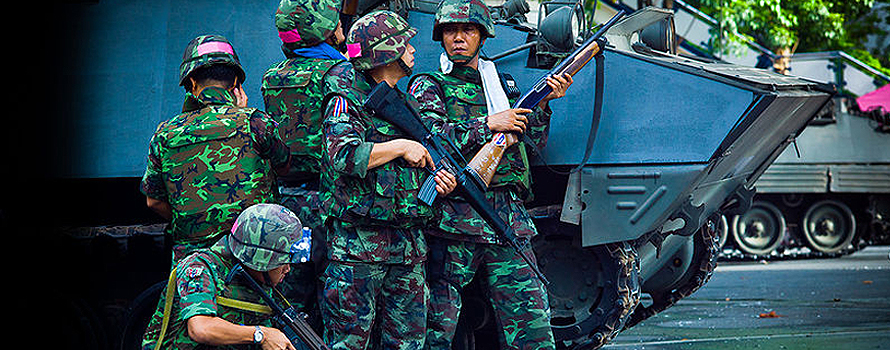
▲Mobilisation of the Royal Thai Armed Forces in 2010 [Roland Dobbins-WC]
COMMENTARY / Álvaro Aramendi Baro
Terrorism is hitting harder and harder in Thailand. The causes of this incipient growth are difficult to pin down. However, the coup d'état of the Royal Armed Forces led by General Prayuth Chan-ocha on May 22, 2014 and, obviously, the subsequent political repressions played a very important role. Nor should we forget the pressure exerted by the BRN (Barisan Revolusi Nasional), which for decades has been fighting for the independence of Pattani (located in the south of Thailand). group revolutionary also operates in northern Malaysia. This terrorist organization is currently used by ISIS. ISIS's strategy, as well as that of Al-Qaeda, is based on encouraging and incentivizing nationalist insurgencies in order to have easier access to those territories under its target.
Despite this, the jihadist influence has taken different paths from those we already know, such as in Iraq or Syria. It is enough to follow the media to guess that the self-styled Islamic State prefers global media expansion to national expansion. This is not the case in Thailand. Both the objectives of terrorism and its communication strategy are national and rather hidden, in the shadows. Because of this, the relationship between them is not entirely evident today.
The status It's not what it should be. If there is one thing Thailand needs today, it is a period of peace in order to recover from past events. In the last century, there have been at least twelve successful coups d'état, the last of them, and not counting the one in 2014, in 2006. There is an urgent need for a quiet period in which to establish a strong foundation, and other structure, for its constitutional monarchy (similar to that of England).
Perhaps the best way to resolve the conflict is to avoid falling into the error of other countries, such as Burma or the Philippines, and to avoid strong repression. That is why, as Crisis Group warns, the best option would be dialogue and not the exclusion of ethnic minorities such as the Rohingya, in the case of Burma, or the Muslim community in Thailand (with a Buddhist majority). Should this happen, the terrorist pressure would become more and more unbearable, until the pot could only explode. Annexation to groups such as ISIS can occur for a variety of reasons, not adding one more to the list is essential.
Showing the range 361 - 370 of 426 results.
